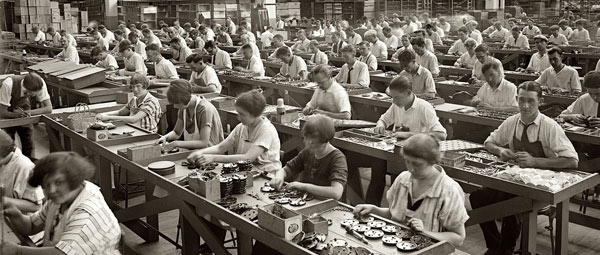
Factories must be awfully dull places. Factory workers working on a production line follow a strict process. Work is divided out into narrow and highly controlled portions. The guy working at machine #1 is an expert at machine #1, but not at machine #2 or #3. But that’s ok; if he stays focussed on his machine, the production line moves on and many widgets will roll off the end.
Factory workers take a given process or specification and assemble it. That the solution is provided is a given. There’s no room for initiative or individual innovation on the factory floor. If one machine doesn’t produce output of exactly the right type at exactly the right time, the system breaks down. Process improvement and innovation is for senior managers; observing the factory floor below from an air-conditioned room behind a wall
of glass.
In the early 1800s the factory revolutionised the production of goods and heralded the onset of the industrial era. It raised millions of people from poverty and created countless jobs (and millionaires). It brought about a new kind of competition: one fought along the bottom line. The problem with the factory is that the race to the bottom is over: we hit it long ago. When every factory can produce widgets as cheaply as you can (or cheaper), your ability to differentiate lies elsewhere – it’s not enough just to be able to sell widgets cheaper than anyone else.
Luckily in the software product business we’re not factory workers. We encourage individual initative. We challenge our teams to help us improve our processes. We believe that innovation can (and should) come from anywhere.
Right?
If that’s true, why do we keep treating our teams like factories, and our people like factory workers? Why do companies push solutions to teams and expect them to be just assembled, (where possible by yesterday), without asking too many questions or making a fuss? Why do organisations rebuff any innovation or ideas that don’t come from their own team? Why do we incentivise teams and individuals on the quantity of output, and not the quality or impact?
It’s not enough to talk about supporting innovation and encouraging initiative… our daily working process has to support it too; otherwise, we’re just another factory.